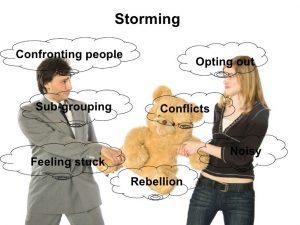 A group is defined as a number of individuals who come together to achieve a particular task or goal. Group dynamics refers to the attitudinal and behavioural characteristics of a group. Group dynamics concerns organizational success because it consists of various groups and a lot depends on how groups form, how they configuration and process, and most importantly how they function. Group dynamics are pertinent in both formal and informal groups of all types. In an organizational setting, groups are a very common organizational entity and the study of groups and group dynamics is an important area of study in organizational behavior.
A group is defined as a number of individuals who come together to achieve a particular task or goal. Group dynamics refers to the attitudinal and behavioural characteristics of a group. Group dynamics concerns organizational success because it consists of various groups and a lot depends on how groups form, how they configuration and process, and most importantly how they function. Group dynamics are pertinent in both formal and informal groups of all types. In an organizational setting, groups are a very common organizational entity and the study of groups and group dynamics is an important area of study in organizational behavior.
There are several theories on why groups develop. The classic theory, developed by George Homans, advocates that group development is based on activities, interactions, and feelings. What it means is when individuals share common activities; they will have more interaction and will develop attitudes which could be positive or negative toward each other. The major element in this theory is what kinds of interaction are shared by the individuals involved in the group.
Social exchange theory offers an alternative explanation for group development. According to this theory, individuals form relationships based on the implied expectation of mutually beneficial exchanges based on trust and felt obligation towards each other. Thus, an insight that in relationships exchange of thoughts and ideas is positive and essential if individuals are to be attracted to and affiliate with a group.
Social identity theory suggests that individuals get a sense of identity and self-esteem based upon their membership in outstanding groups. The nature of the group may be demographically based, culturally suitable, or organizationally based. Individuals are motivated to belong to and contribute to identical as their character groups because of the sense of belongingness and self-worth membership in the group imparts.
Do you know that the study of group dynamics is dated back to 1960s by Bruce Tuckman. He said that groups do not usually perform at maximum effectiveness when they are first established. They come across several stages of development as they struggle to become productive and effectual. Often, groups experience similar developmental stages while they encounter conflicts and resolutions. According to Tuckman’s theory, there are five stages of group development: forming, storming, norming, performing, and adjourning. During these stages group members go through lot of pains as they need to address several issues and the way in which these issues are resolved decides whether the group will succeed in accomplishing its tasks or the group will break up.
Forming: This is the first stage. In this stage lot groups form temporarily; this stage is characterized by some puzzlement and lot of uncertainty. The group is not sure about their major goals. Leadership matters here a lot. Thus, forming is a direction period when members get to know one another and share expectations about the group. Members learn the purpose of the group as well as the rules to be followed. If the forming stage is rushed trust and openness cannot be developed. Individuals are often confused during this stage because roles are not clear and leadership matters to bring in a feeling of settlement. If the group is formed on basis of weak leadership, the group is far from being formed.
 Storming: This stage is called storming because in this stage, the group is likely to see the highest level of incongruity and conflicts. Members in the group challenge group goals and struggle for power. Individuals often compete for the leadership position during this stage of development. This can be a positive experience for all groups if members can get organized through resolution. Members often voice concern and criticism in this stage. If members are not able to determine the conflict, then the group will often split up or continue in existence but will remain unproductive and never advance to the further stages.
Storming: This stage is called storming because in this stage, the group is likely to see the highest level of incongruity and conflicts. Members in the group challenge group goals and struggle for power. Individuals often compete for the leadership position during this stage of development. This can be a positive experience for all groups if members can get organized through resolution. Members often voice concern and criticism in this stage. If members are not able to determine the conflict, then the group will often split up or continue in existence but will remain unproductive and never advance to the further stages.
Norming: This stage is categorized by the identification of individual differences and shared expectations. If in this stage the group members begin to develop a feeling of group unity and identity the group’s existence strengthens. They experience cooperative efforts which begin to yield results. In this stage usually responsibilities are divided among members and the group decides on evaluating progress. Roles and responsibilities are passed on to members in the group in norming stage.
Performance: Performance of group occurs when the group matures and attains a feeling of cohesiveness. During this stage of development, individuals accept one another and conflicts are resolved through group discussions. Members of the group make decisions through a sensible process that is focused on relevant goals rather than emotional issues.
 Adjourning: This stage is not is not experienced by all groups, because it is characterized by the performance discharged by the group. Some groups stay relatively permanent. There are reasons why groups disband; they differ from group to group. Some common reasons are the achievement of the tasks or individuals deciding to go their own ways. Members of the group often experience feelings of conclusion and sorrow as they prepare to leave the group. The reasons could be rational or irrational.
Adjourning: This stage is not is not experienced by all groups, because it is characterized by the performance discharged by the group. Some groups stay relatively permanent. There are reasons why groups disband; they differ from group to group. Some common reasons are the achievement of the tasks or individuals deciding to go their own ways. Members of the group often experience feelings of conclusion and sorrow as they prepare to leave the group. The reasons could be rational or irrational.
 We human beings don’t always make the right decisions because our rational judgment is influenced not only by our infatuations and emotions but we all have built-in biases and some other feelings as conceit, egos and illogical dogmas. We don’t understand sometimes why we behave in a fashion or why we take wrong decisions. One big factor affecting the quality of decisions is whether a decision involves a group.
We human beings don’t always make the right decisions because our rational judgment is influenced not only by our infatuations and emotions but we all have built-in biases and some other feelings as conceit, egos and illogical dogmas. We don’t understand sometimes why we behave in a fashion or why we take wrong decisions. One big factor affecting the quality of decisions is whether a decision involves a group.
Group dynamics can lead otherwise sensible individuals to agree or disagree decisions they might not come to on their own. At times the effects are positive, as when some group members help others overcome discrimination. But the dynamics of a group often have negative consequences. Since most organizations rely on collective decision making in some contexts, managers must to be on the lookout for group biases and their undesirable results. There are again some common manifestations of the group effectiveness. Such as conformity – many people go along with the group regardless of what they themselves might think as individuals. Then comes group polarization – it’s a phenomenon which shows that deliberation can intensify people’s attitudes, leading to more extreme decisions. A study in US federal courts showed that judges working alone took a relatively extreme course of action only 30% of the time. When they were working in groups of three, this figure more than doubled, to 65%.
It has been observed that it is an elating feeling when like minded people come together in a group. It is an exhilarating to see when a team of dedicated people meet to discuss and decide a course of action which benefits each member in the group. If a group is given freedom to choose whom and whom not it can have in its team, positive performance can be observed. It is always gratifying to have likeminded people to form groups. They work together, though each of them coming from different backgrounds and levels of experience, but each with the same intellectual capacity to problem-solving and eventually come up with well executed outcomes. People with similar points of view can supplement and substantiate the perspectives which help in achieving organizations goals and objectives.
I like Margaret Mead’s quote “Never doubt that a small group of thoughtful committed citizens can change the world; indeed it’s the only thing that ever has” this sums what group dynamics is all about beautifully.













































